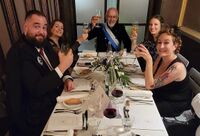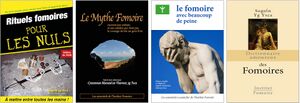Formori Community
Formori Community Communauté Fomoire | |
|---|---|
|
Flag | |
| Motto: "Parfois s'endort, jamais ne meurt" "Might be asleep, never dead" | |
| Status | Active |
| Location | Non-territorial micronation |
| Recognised national languages | French, Formori |
| Recognised regional languages | English, German, Spanish |
| Demonym(s) | Formori |
| Government | Direct democracy |
• President of the Formori Institute | Sogoln yg Ysca |
| Cultural community | |
• Foundation | October 1991 |
• Creation of the Institute | 1 September 1992 |
| Population | |
• 2023 census | 223 |
Website www | |
The Formori Community (French: La Communauté fomoire) is a micronation mostly based in France, but with members in Austria, Belgium, Canada, Finland, Mauritius, Switzerland, the United Arab Emirates, the United Kingdom and the United States. It was founded in October 1991 with the intent of creating a culture inspired by the Formori people from ancient Irish mythology in order to rehabilitate indigenous peoples.
The Formori Community is an informal group with no actual government-like structure. Its activities are managed by the Formori Institute, a non-profit association under France's 1901 legislation.
Without actual government, the Formori Community is not seeking recognition from other micronations and is not able to maintain any formal foreign policy. Nevertheless, it maintains friendly relationship at personal levels with multiple micronations and is an observer in the MicroFrancophonie.
Etymology
The Formori Community takes its name from the Formori of ancient Irish mythology. According to Irish lore, they are an evil race opposing the heroic Tuatha Dé Danann in their attempt to conquer Ireland. Eventually, they are "wiped out from the surface of the Earth" by the Tuatha Dé Danann, who are later defeated by the Milesians, the actual ancestors of the Irish, and turned into pixies. The Formori Community identifies the mythical Formori as a forgotten indigenous European people eradicated by proto-Indo-European invaders.
History
The Formori Community was founded in October 1991, by three French graduates with a long common past in role-playing games, who adopted the Formori names Ars yg Lessar, Yçery yg Mencar and Sogoln yg Ysca. The project to foster a Formori-inspired culture resulted from a long discussion on the Irish Book of Invasion, which depicts the Formori as cyclops, giants and monsters as a justification to their demise.
The Formori Institute was created as a non-profit organization under French law in september 1992 to manage the various creative projects regarding the Formori Language, the calendar, the social structures, the cuisine, and more, as well as the rewritting of the Myth as seen from the Formori point of view.
As most of the early modern Formori were students, the Community underwent a diaspora when they all graduated and dispersed themselves around the globe at pre-Internet times. This resulted in limited activities until contact was fully restored as the new communications tools became widely available. In 1995, a first Formori lexicon was published and a first version of the Formori website was put online using the GeoCities platform in 1996-1997. However, it was discontinued due to the lack of activity.

A new website was inaugurated in 2000 and the connection with the Community at large was restored. By 2001 the Formori Community participated in the First Intermicronational Exposition organized by Molossia.
In 2004, following the example set by Jirmania, the Formori Community decided to adopt a national flag to be shown all around the world. The "Goose-footed" design (in French: "Pédauque") was selected among more than 50 proposals and made its debut in the Principality of Monaco in August 2005. In 2007, it was also part of ÉTATS (faites-le vous-même)/States (Do it yourself), Peter Coffin's exhibition about micronations at Palais de Tokyo in Paris. By October 2023, the Formori flag has been photographed in 75 countries, 20 territories and 16 micronations. A photo exhibit is planned for 2024.
Entry into the intermicronational community

In 2012, a delegation from the Formori Community participated to the PoliNation 2012 conference in London, with Sogoln yg Ysca presenting a paper entitled "A Lamarckian Approach to Micronationalism", introducing the Formori approach of gathering a people before setting up governement structure only when they are actually needed to solve issues. In 2013, Sogoln yg Ysca also participated to the 2013 Intermicronational Summit in Paris, representing the Formori in a less formal way.
In 2015, the Formori Community again participated to the PoliNation 2015 conference in the Free Republic of Alcatraz, in Italy. There, the Formori delegation met delegates from the Principality of Aigues-Mortes and Empire of Angyalistan and was invited to join the embryonic Organisation de la MicroFrancophonie (OMF) as an observer. The Formori have since been traditional contributors to OMF summits and events organized by the OMF members, such as Aigues-Mortes' Grand Princely Ball of the Golden Bucket, or the Grand Coronation of the Prince of Heliantis in 2023.
In 2024, the Formori Community will organize the 4th Summit of MicroFrancophonie, to be held in Saint-Antoine-l'Abbaye, France.
Politics and government
The Formori Community has no form of government. The cultural effort is managed by the Formori Institute, under the presidency of Sogoln yg Ysca. Other projects are conducted and funded on a voluntary basis.
The officiel policy is that the Community might consider setting up a minimum government if problems arise. It would be based on an assembly of all the Formori citizens, to be known as the "Pandemon" (from Pan- "All" and Demos "The People"). Only when needed, this Pandemon would elect a "Tyran" to take charge and responsibility of a single project on a limited duration, or a couple of "Shophets" to discuss a controversial issue and agree on a decision.
Military
The Formori Community decided at its inception to never set up any kind of military force since it has no legitimacy to maintain one.

Foreign relations
The Formori Community maintains no formal foreign policy, except for their observer status in the MicroFrancophonie. However, several Formori individuals maintain close personal relationship with various micronational leaders.
Economy
The Formori culture does not recognize the concept of money.
Culture
The cultural development is the main objective of the Formori Community. The Formori Institute is actively trying to gather elements developped community-wide and maintain some kind of coherence. It is in charge of a library of sources known as the Oisif fund for "Ouvrages Intéressants et Sources d'Inspiration Fomoires" (Interesting works and sources of Formori inspiration).

The Formori Institute publishes a trimestrial liaison bulletin, La Feuille de l'Aulne (The Alder Leaf), and every new year's calendar.
It is also in charge of several reference PDF manuals, regarding traditions (Formori rituals for dummies), the Myth (The Formori myth for kids and adults who don't have the courage to read a big book), the language (The Formori with a lot of pain), the cuisine (Formori feasts and libations), or generalities (The lovers' dictionary of the Formori). There have been attempts of Formori poetry as well.
Amongst the Institute's responsibility is listing the members of the Community. These members have chosen a Formori name and are organized through Houses, each of which refers to a tree or a tree-like plant. As of 2023, there are 43 registred Formori Houses.
From 2001 to 2005, the Formori Institute published a series of commemorative e-stamps, in gif and jpg format, for e-mails.
Holidays
The Formori have their own luni-solar calendar, with an era starting in 1508 BCE. Most of Fomori holidays are set according to this reference and not to the Gregorian calendar.
| Date | Name | Remarks |
|---|---|---|
| Around 20 March (Spring Equinox) | Songo | Formori New Year's Day. |
| 19 April | The Cave Day | Celebration of Saint Engratia. |
| Late April/Early May (Mid-Spring New Moon) | Belythaun | Rebirth of nature festival. |
| 25 May | Canvas Day | Celebration of the Formori costume. |
| Around 21 June (Summer Solstice) | Solstice | Music festival. |
| Late July/Early August (Mid-Summer New Moon) | Ornasayn | Abundance festival. |
| Around 22 September (Autumn Equinox) | Mutaraun | Engagement festival. |
| Late October/Early November (Mid-Automn New Moon) | Samayn | The last encounter before winter. |
| 3-5 November | The Matrons' Days | Celebration of Saint Engratia and Saint Silvia. |
| In November (Second Full Moon of Autumn) | The Big Cry | The day of the big primal scream (a Thanksgiving antithesis). |
| Around 22 December (Winter Solstice) | Eathoan | Vigil of the longest night. |
| Around 1 January (12 days after Eathoan) | The Visit | The day of unexpected visitors. |
| 17-20 January | The Tauliers' Days | Celebration of Saint Anthony of Egypt and Saint Sebastian. |
| Late January/Early February (Mid-Winter New Moon) | Imbolga | The first lactation of the ewes. |
